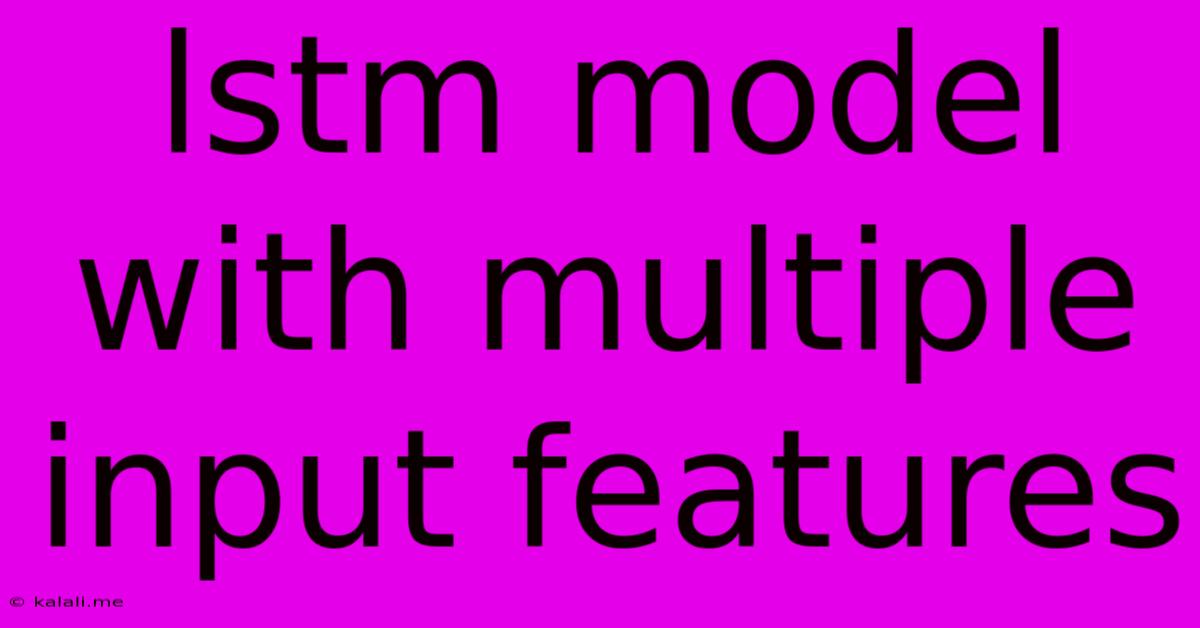Lstm Model With Multiple Input Features
Kalali
May 24, 2025 · 4 min read

Table of Contents
LSTM Models with Multiple Input Features: Enhancing Predictive Power
Meta Description: Discover how to leverage the power of Long Short-Term Memory (LSTM) networks by incorporating multiple input features. This guide explains the process, benefits, and considerations for building more accurate and robust predictive models.
Long Short-Term Memory (LSTM) networks are a powerful type of recurrent neural network (RNN) particularly well-suited for sequential data. While often demonstrated with single input sequences, their true strength lies in their ability to handle and integrate information from multiple input features. This article explores how to effectively build and train LSTM models that utilize multiple input features, significantly enhancing their predictive capabilities.
Understanding the Power of Multi-Feature LSTM
A single input sequence, like a time series of stock prices, might only tell part of the story. Adding other relevant features, such as trading volume, economic indicators (e.g., inflation rate, interest rates), or even social media sentiment, can dramatically improve the accuracy and robustness of your LSTM's predictions. By incorporating these diverse data sources, you create a richer, more comprehensive representation of the underlying dynamics driving the target variable.
Methods for Integrating Multiple Input Features
There are several ways to integrate multiple input features into an LSTM model:
-
Concatenation: This is the simplest approach. Each feature's time series is represented as a separate sequence. These sequences are then concatenated horizontally at each time step, resulting in a single input sequence with multiple dimensions. This method assumes a linear relationship between features, which may not always be the case.
-
Separate LSTM Branches: A more sophisticated approach involves using separate LSTM layers for each input feature. The outputs of these individual LSTM layers are then combined (e.g., concatenated or averaged) before feeding them into a final fully connected layer for prediction. This method allows the model to learn separate representations for each feature, capturing potentially non-linear relationships.
-
Attention Mechanisms: Attention mechanisms allow the LSTM to selectively focus on different input features at different time steps. This is particularly useful when dealing with features of varying importance or relevance. Attention mechanisms learn weights that assign different levels of importance to each feature at each time step, improving the model's ability to capture complex interactions.
-
Embedding Layers (for Categorical Features): If you have categorical features (e.g., weather conditions, industry sectors), you'll need to convert them into numerical representations before feeding them to the LSTM. Embedding layers are excellent for this purpose. They learn a low-dimensional vector representation for each category, capturing semantic relationships between them.
Practical Considerations and Implementation Details
-
Data Preprocessing: Thorough data preprocessing is crucial. This includes handling missing values, scaling features (e.g., using standardization or min-max scaling), and ensuring consistent data types.
-
Feature Engineering: Effective feature engineering can significantly improve your model's performance. This involves creating new features from existing ones to capture potentially valuable information.
-
Hyperparameter Tuning: Experimenting with different hyperparameters, such as the number of LSTM units, the number of layers, and the learning rate, is essential for optimal performance. Techniques like grid search or randomized search can be used to efficiently explore the hyperparameter space.
-
Model Evaluation: Choose appropriate evaluation metrics based on your specific problem. Common metrics include Mean Absolute Error (MAE), Root Mean Squared Error (RMSE), and R-squared. Remember to use techniques like cross-validation to obtain robust estimates of model performance.
Advantages of Using Multiple Input Features
-
Improved Accuracy: The most significant benefit is an increase in predictive accuracy. By providing a more complete picture of the underlying dynamics, the LSTM can make more informed predictions.
-
Enhanced Robustness: Models with multiple input features are often more robust to noise and outliers in individual features. The model can rely on other features if one feature is unreliable.
-
Better Generalization: Using multiple features improves the model's ability to generalize to unseen data. This makes it more reliable in real-world applications.
Conclusion
Incorporating multiple input features significantly enhances the capabilities of LSTM models. By thoughtfully selecting relevant features, applying appropriate integration methods, and carefully considering preprocessing and hyperparameter tuning, you can build robust and highly accurate predictive models capable of addressing complex problems across diverse domains. Remember to thoroughly evaluate your model's performance using appropriate metrics and validation techniques.
Latest Posts
Latest Posts
-
Which Of The Following Is True Concerning A Dao
Jul 02, 2025
-
How Long Can Catfish Live Out Of Water
Jul 02, 2025
-
Is Kanye West Related To Cornel West
Jul 02, 2025
-
Olivia Needs To Provide A Visual Summary
Jul 02, 2025
-
How Many Cups Of Macaroni In A Pound
Jul 02, 2025
Related Post
Thank you for visiting our website which covers about Lstm Model With Multiple Input Features . We hope the information provided has been useful to you. Feel free to contact us if you have any questions or need further assistance. See you next time and don't miss to bookmark.